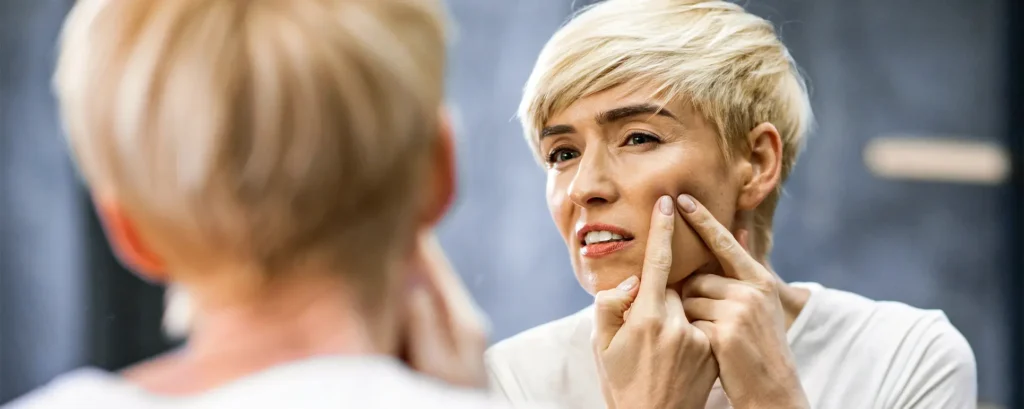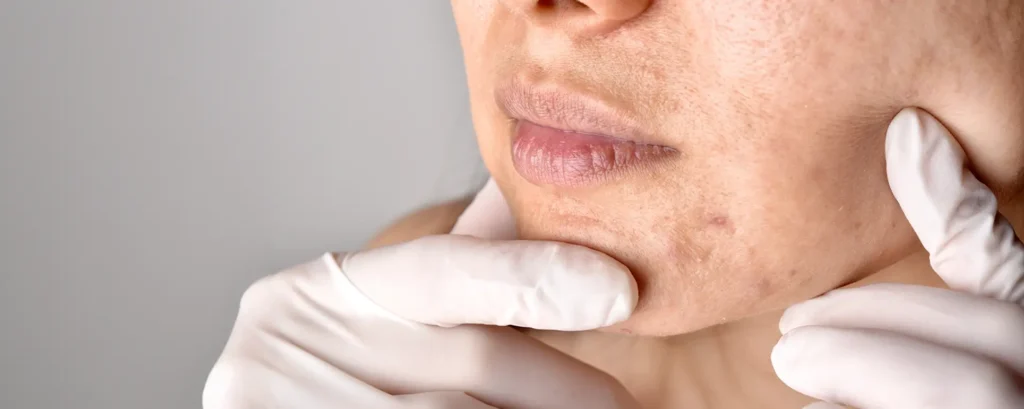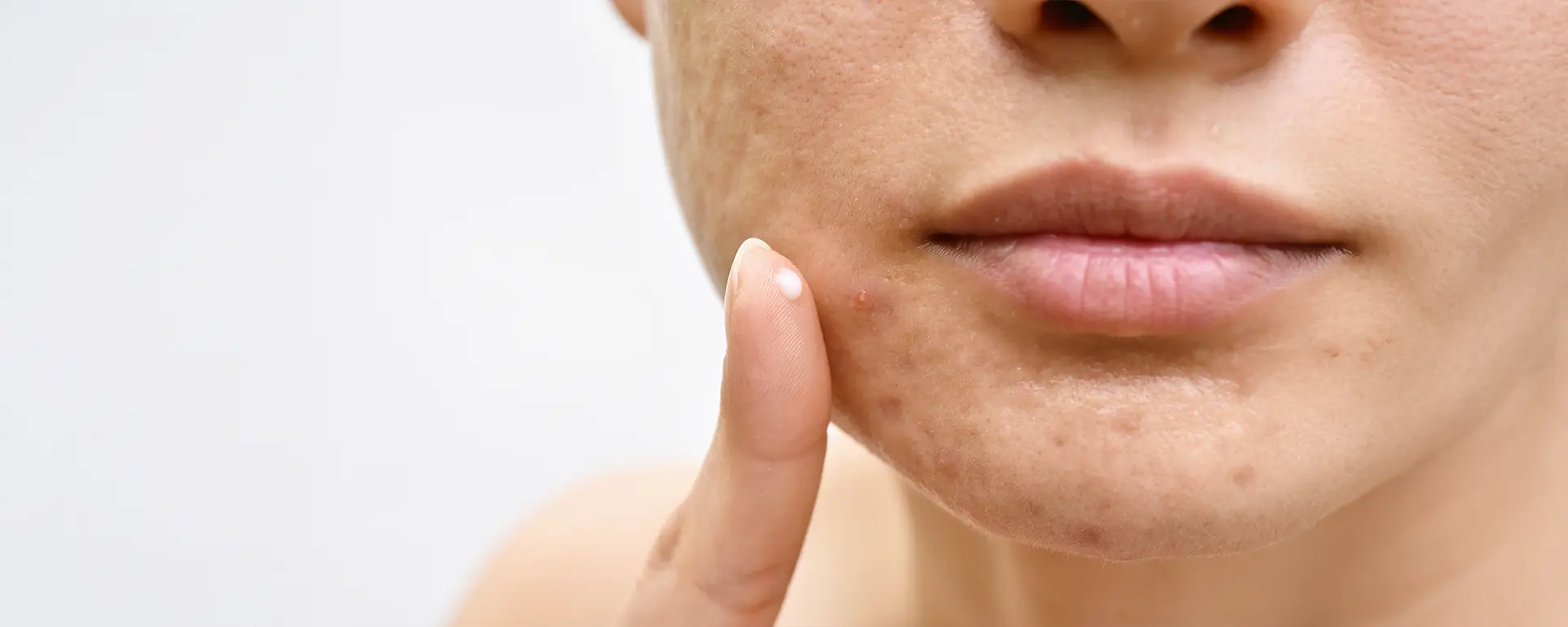Many people assume that acne is only a teenage problem that naturally disappears with age, but in reality, breakouts can persist well into adulthood. In fact, spots in your 30s and 40s are more common than most people think. These adult breakouts can feel particularly frustrating because they often appear when you expect your skin to be at its most balanced and stable.
Unlike teenage acne, which is usually linked to puberty and rapidly changing hormones, adult spots can be triggered by a wider range of factors. For some, breakouts show up in the same areas as before such as the forehead, nose, or chin while others may notice new patterns, with blemishes developing along the jawline, cheeks, or even the neck. This change in location can make adult acne feel different from what you experienced in your teens.
Spots during your 30s and 40s can be caused by hormonal fluctuations, stress, lifestyle factors, skincare routines, or even underlying health changes. For example, hormonal imbalances related to the menstrual cycle, pregnancy, perimenopause, or conditions like polycystic ovary syndrome (PCOS) can all contribute to persistent acne. Stress, lack of sleep, and poor diet may also disrupt your body’s natural balance, increasing oil production and inflammation.
On top of that, using heavy cosmetics, harsh cleansers, or skincare products not suited to your skin type can clog pores and worsen breakouts. Some people may also develop spots as a reaction to medication or due to environmental factors like pollution. Because your skin’s ability to regenerate slows with age, blemishes may take longer to heal and can leave behind marks or pigmentation that linger longer than they did in your teenage years.
So, if you find yourself dealing with spots in your 30s or 40s, you’re not alone
it’s a widespread issue, and there are many possible explanations. Understanding the root cause of your breakouts is the first step to finding an effective treatment plan tailored to your skin’s needs.
Common Causes of Adult Acne

Hormonal changes
Hormonal fluctuations are perhaps the most significant cause of adult acne. Androgens, a type of hormone present in both men and women, stimulate the sebaceous (oil) glands to produce sebum. When sebum mixes with dead skin cells and bacteria, pores become blocked, resulting in inflammation and breakouts.
In women, hormone-related acne can be linked to several life stages and changes. Flare-ups often occur around the menstrual cycle, when estrogen and progesterone levels drop and androgens have a stronger influence. During pregnancy, shifting hormone levels may improve skin for some women but worsen it for others. In perimenopause and menopause, declining estrogen levels can throw off the hormonal balance, sometimes leading to new or worsening acne.
A telltale sign of hormonal acne is its pattern painful, deep cyst-like spots that appear around the jawline, chin, and neck. Unlike surface-level pimples, these blemishes form deeper under the skin and may linger longer, leaving behind dark marks or scars. In some cases, medical conditions such as polycystic ovary syndrome (PCOS), which causes excess androgen production, can make acne particularly persistent and resistant to conventional over-the-counter treatments.
Stress
Stress doesn’t just affect your mood and energy levels it has a direct impact on your skin. When you’re under stress, your body produces more cortisol and other stress-related hormones. Cortisol can disrupt your skin’s balance, increasing oil production and making your sebaceous glands more active. This overproduction of oil, combined with everyday impurities, clogs pores and creates an environment where acne-causing bacteria thrive.
Stress also fuels inflammation throughout the body, which worsens redness, swelling, and irritation in existing breakouts. To make matters worse, stress often leads to unhelpful lifestyle habits: poor sleep, comfort eating (especially sugary and greasy foods), neglecting skincare routines, or even picking at spots, which can make acne worse and lead to scarring.
Many adults notice a clear link between stressful events tight work deadlines, major life transitions, or lack of rest and sudden flare-ups. This “stress-acne cycle” can become frustrating: stress causes acne, and then acne causes more stress, creating a loop that’s hard to break.
Skincare and lifestyle factors
Your skincare and daily habits can either support healthy skin or contribute to frequent breakouts. Using the wrong products for your skin type such as heavy, comedogenic moisturisers, sunscreens, or makeup can clog pores and trigger spots. On the other hand, over-cleansing or using products that are too harsh (like those with sulfates, high alcohol content, or strong exfoliating acids used too often) can strip the skin of its protective barrier. When the skin barrier is damaged, the body may compensate by producing more oil, which ironically leads to more breakouts.
Lifestyle choices are equally important. Diets high in refined sugar, dairy, and processed foods have been linked to acne because they can increase insulin levels and fuel inflammation. Dehydration and insufficient sleep impair the skin’s ability to repair and regenerate, slowing the healing process of blemishes. Smoking and excessive alcohol consumption further weaken the skin’s defenses, reduce oxygen supply, and make acne more difficult to manage.
External and environmental factors also play a role. Pollution, sweat, humidity, and friction from tight clothing, helmets, or face masks (“maskne”) can block pores and trigger irritation. People who regularly work out and don’t shower or cleanse promptly afterward may also experience body acne on the back, chest, or shoulders.
Underlying health conditions
Sometimes, persistent adult acne is more than just a surface-level issue and is linked to internal health concerns. Hormonal disorders like PCOS are among the most well-known contributors. Women with PCOS often experience irregular menstrual cycles, excess hair growth, weight gain, and chronic acne due to higher androgen levels. Thyroid imbalances, both hypothyroidism and hyperthyroidism, can also disrupt skin health by interfering with hormone regulation, sebum production, and cellular turnover.
Blood sugar imbalances and insulin resistance can trigger acne as well. High insulin levels stimulate androgen activity, which in turn increases oil production. Some people with digestive issues, such as gut dysbiosis or food intolerances, also report more frequent breakouts, possibly due to inflammation and poor nutrient absorption.
Certain medications can make acne worse, including corticosteroids, lithium, and some types of hormonal birth control. Because these underlying conditions are systemic, acne related to them often does not fully respond to topical skincare alone. In such cases, seeking medical advice to identify and address the root cause is essential to achieving long-term skin clarity.
Genetics
If acne is something that runs in your family, there is a much higher chance that you will also experience spots during adulthood, even if you never had severe acne as a teenager. Research shows that hereditary factors can influence almost every aspect of how your skin behaves, making genetics one of the most powerful predictors of adult acne.
One of the key ways genetics plays a role is through the activity of the sebaceous glands. If your parents or close relatives naturally have overactive oil glands, you may have inherited the same tendency, which increases sebum production and makes it easier for pores to become clogged. Genetics also determines how your skin reacts to hormonal changes, which is why some people are more prone to hormonal breakouts around the chin and jawline, while others may hardly notice any flare-ups.
In addition, inherited traits can affect how your immune system responds to acne-causing bacteria and skin inflammation. Some people’s skin reacts very aggressively to even small amounts of bacteria, leading to red, painful, and stubborn spots, while others may experience milder forms of acne that heal more quickly. Genetics can also play a role in how efficiently your skin repairs itself after breakouts. If your skin is genetically slower to heal, you may notice lingering marks, pigmentation, or scarring that lasts much longer than usual.
Even though your genetic background cannot be changed, this knowledge can help you take more proactive steps in managing your skin health. If you know that acne is common in your family, being consistent with a gentle but effective skincare routine, avoiding comedogenic products, and seeking professional advice early on can make a big difference. Dermatologists can recommend treatments designed to target genetically driven acne, from prescription-strength topicals to advanced therapies like chemical peels, laser treatments, or microneedling for scarring. With the right approach, even genetically influenced acne can be controlled, and your skin can remain clearer and healthier well into adulthood.
How a Dermatologist Can Help

If you’re experiencing persistent breakouts in your 30s, 40s, or beyond, it can feel discouraging especially if you thought acne was a problem only associated with teenage years. Adult acne, however, is extremely common, and in many cases it requires more than just shop-bought cleansers or spot creams. This is where visiting an Acne Clinic in London or booking a consultation with a dermatologist can be transformative. A dermatologist doesn’t just treat the visible spots; they take the time to understand what’s happening beneath the surface and why your skin continues to break out.
Dermatologists are trained to combine medical expertise, diagnostic tools, and patient history to create an individualised treatment plan. Instead of trial and error, you receive professional guidance that considers your skin type, health background, lifestyle, and personal goals.
Comprehensive Diagnosis and Root Cause Identification
The first step a dermatologist takes is to carefully assess your acne. Adult breakouts can look different from teenage acne sometimes appearing as deep, painful cysts on the chin and jawline, or as smaller, inflamed spots across the cheeks and forehead. A dermatologist will evaluate:
- Your medical history – checking for hormonal imbalances, medications, or conditions like PCOS and thyroid issues.
- Lifestyle factors – diet, stress levels, sleep quality, and skincare routine.
- Skin type and sensitivity – identifying whether your skin is oily, combination, or prone to irritation.
- Patterns of breakouts – noting where spots appear most frequently, which often points to hormonal or external triggers.
By identifying the underlying cause whether it’s hormonal, bacterial, inflammatory, or environmental the dermatologist can recommend targeted treatments instead of one-size-fits-all solutions.
Prescription Topical Treatments
Over-the-counter creams often don’t have the strength to tackle stubborn adult acne. Dermatologists can prescribe topical medications that are more effective, including:
- Retinoids (such as tretinoin or adapalene), which increase cell turnover, unclog pores, and improve skin texture over time.
- Benzoyl peroxide, a powerful antibacterial agent that reduces acne-causing bacteria and prevents new breakouts.
- Topical antibiotics, to reduce inflammation and bacterial overgrowth.
- Azelaic acid or salicylic acid preparations, which can gently exfoliate, fade dark marks, and help prevent clogged pores.
Because prescription treatments can sometimes cause dryness or irritation, dermatologists carefully adjust concentrations and combine products in a way that maximises results while minimising side effects.
Oral Medications for Resistant or Hormonal Acne
When topical treatments aren’t enough, dermatologists may recommend oral medications. These are especially useful for hormonal acne or widespread, inflamed breakouts. Options include:
- Oral antibiotics – to quickly reduce inflammation and bacterial growth.
- Hormonal treatments – such as oral contraceptives or anti-androgen medications like spironolactone, which can balance hormones and regulate oil production.
- Isotretinoin (Roaccutane) – a highly effective long-term solution for severe or scarring acne, carefully prescribed and monitored by dermatologists.
These medications are prescribed after a thorough consultation and often involve regular check-ins to monitor progress, adjust dosage, and ensure safety.
Tailored Skincare Routines
Many adults with acne unknowingly use products that worsen their condition. A dermatologist can help streamline your skincare routine by recommending:
- Gentle, non-comedogenic cleansers
- Lightweight, oil-free moisturisers that support hydration without clogging pores
- Broad-spectrum sunscreens that protect against sun damage without exacerbating acne
- Targeted serums, such as niacinamide for calming inflammation or hyaluronic acid for hydration
This personalised approach saves time, money, and frustration, helping you avoid trial-and-error experiments with dozens of products.
Advanced In-Clinic Treatments
Dermatologists also offer access to professional treatments that go beyond what you can achieve at home, such as:
- Chemical peels – to exfoliate, improve texture, and reduce acne scars.
- Laser therapy – to shrink oil glands, reduce redness, and target pigmentation.
- Light-based treatments (blue or red light) – which kill acne-causing bacteria and calm inflammation.
- Microneedling and resurfacing procedures – to improve skin texture and reduce long-term scarring.
These treatments not only help with active acne but also address the after-effects, like dark marks, uneven tone, and scarring that often accompany adult breakouts.
Lifestyle, Nutrition, and Stress Management Advice
Since acne is rarely caused by just one factor, dermatologists often consider the whole lifestyle picture. They may provide guidance on:
- Nutrition: limiting high-glycaemic foods, dairy, or excessive sugar if they seem to trigger flare-ups.
- Sleep: encouraging better rest to allow skin repair and hormonal balance.
- Stress: recommending techniques such as mindfulness, yoga, or relaxation strategies to break the stress-acne cycle.
- Habits: avoiding over-washing, picking at skin, or wearing heavy makeup that clogs pores.
By combining medical treatment with lifestyle adjustments, dermatologists create a balanced, sustainable plan for healthier skin.
Long-Term Guidance and Emotional Support
Acne can have a profound effect on self-esteem, especially for adults who feel it’s “too late in life” to still be dealing with spots. Dermatologists not only treat the skin but also provide ongoing emotional reassurance and professional support. Regular appointments allow for progress tracking, timely adjustments to treatment, and encouragement along the journey to clearer skin.
This ongoing partnership ensures that you are never left to guess whether a product or treatment is working. Instead, you benefit from evidence-based recommendations and a clear roadmap toward long-term results.
The Value of Professional Care
Ultimately, seeing a dermatologist at an acne clinic is about more than just clearing spots it’s about reclaiming confidence, comfort, and control over your skin. With the right combination of medical treatments, tailored skincare, professional procedures, and lifestyle guidance, dermatologists help patients achieve healthier skin that lasts well beyond temporary fixes.
Final Thought: Clear Skin Is Possible at Any Age

Adult acne in your 30s and 40s is more common than you might think, and while it can be frustrating, it is often linked to manageable factors like hormonal changes, stress, lifestyle habits, or underlying health conditions. With the right guidance, clear and healthy skin is achievable. If you’re ready to take control of your skin concerns, you can get in touch with us to book a consultation with our acne clinic in London for expert advice, tailored treatments, and long-term solutions.
References:
- Bagatin, E., Freitas, T.H.P., Rivitti-Machado, M.C.R., Ribeiro, B.M., Nunes, S., Rocha, M.A. and Geller, L. (2019). Adult female acne: a guide to clinical practice. Anais Brasileiros de Dermatologia, 94(1), pp.62–75.
Available at: https://www.ncbi.nlm.nih.gov/pmc/articles/PMC6360964/ - Perkins, A.C., Cheng, C.E., Hillebrand, G.G. and Miyamoto, K. (2018). Adult-onset acne: prevalence, impact, and management challenges. International Journal of Women’s Dermatology, 4(2), pp.56–65.
Available at: https://www.ncbi.nlm.nih.gov/pmc/articles/PMC5798558/ - Yale Medicine (2023). Acne (Acne Vulgaris). Yale Medicine.
Available at: https://www.yalemedicine.org/conditions/acne - Harvard Health Publishing (2022). Adult female acne: Why it happens and the emotional toll. Harvard Health Blog.
Available at: https://www.health.harvard.edu/blog/adult-female-acne-why-it-happens-and-the-emotional-toll-202206272768
Liu, Y.-T., Wang, Y.-W., Tu, C., Ren, J.-W., Huo, J., Nan, X.-J., et al. (2024). Recommendations for managing adult acne and adolescent acne based on an epidemiological study conducted in China. Scientific Reports, 14, 16327.
doi: https://doi.org/10.1038/s41598-024-67215-2
